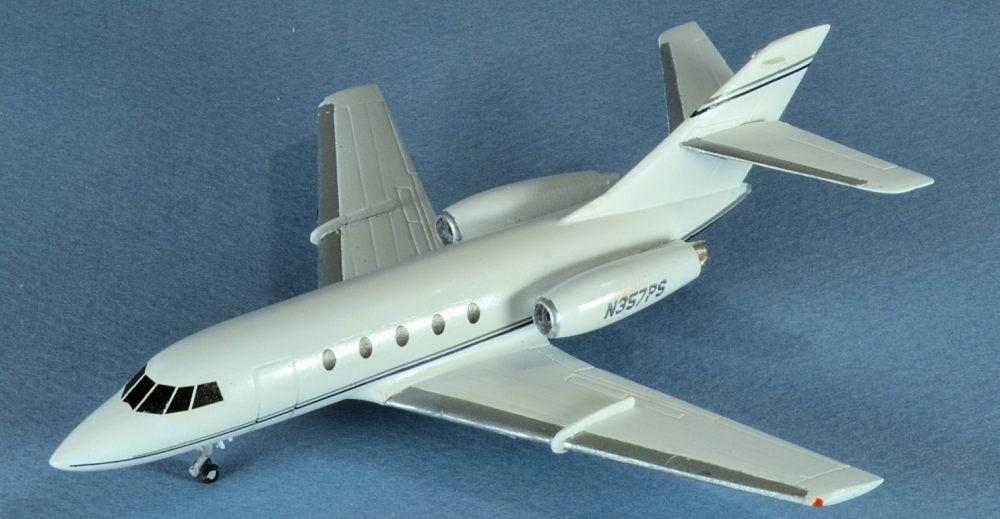
F-RSIN 1/144 Dassault Falcon 20
| KIT #: | FRP 4015 |
| PRICE: | $25.00 |
| DECALS: | One option |
| REVIEWER: | Ben Brown |
| NOTES: | Short run |

| HISTORY |
First flown in 1963, the
Dassault Mystere 20 is a French-built corporate and military jet that is capable
of carrying 8 to 10 passengers. By request of Pan American, the jetís original
Pratt & Whitney JT12A-8 engines were replaced with General Electric CF700s and
some dimensions were increased. Pan American became the US distributor of the
Mystere 20, calling it the Fan Jet Falcon, and later, the Falcon 20. By 1967,
Pan American Business Jets Division had 160 Falcons on order. An improved Falcon
20, the 200, first flew in 1980. Among other performance improvements were new,
higher-thrust Garrett ATF3 engines.
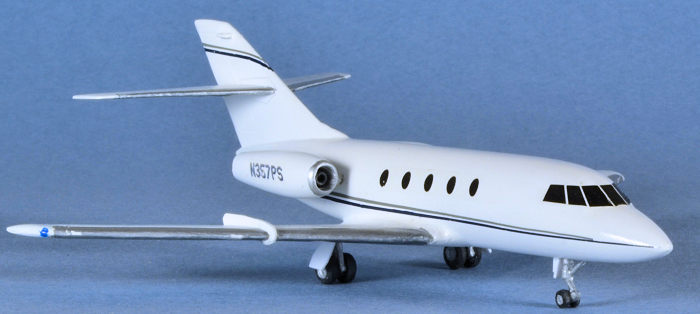 Since the 1980s, a popular modification to
the CF700-powered jets was to retrofit them with Garrett 731 turbofans. This
modification gave the jet much better take-off and high altitude performance,
and almost doubled its range. The new engines allowed the Falcon 20 to meet US
Stage III noise regulations, and by now, most operational jets have probably
been modified.
Since the 1980s, a popular modification to
the CF700-powered jets was to retrofit them with Garrett 731 turbofans. This
modification gave the jet much better take-off and high altitude performance,
and almost doubled its range. The new engines allowed the Falcon 20 to meet US
Stage III noise regulations, and by now, most operational jets have probably
been modified.
In addition to corporate operators, many military air forces flew Falcon 20s, including France, Iran, Belgium, and the US. The US Coast Guard flew 41 HU-25s (based on the Falcon 200) from 1978 until September 2014. Between 1964 and 1988, 508 Falcon 20s and 200s were built, with most going to the US.
Federal Express began its delivery service in 1973 flying Falcon 20s. It eventually operated 33 Falcon 20s, until they were replaced with larger jets. The first Federal Express jet to carry a package is now preserved in the National Air and Space Museum.
| THE KIT |
The Falcon 20 has always been one of my favorite civilian jets, its clean lines giving it the same look of speed, even while sitting on the ramp, as Mirage fighters of the day. Sadly, civil aircraft are poorly represented in the modeling world, especially in my favorite 1/48 scale. The only other kits of the Falcon 20 I know of are Hellerís primitive and long-out of production 1/50 and 1/100 kits from the 1960s, and Mach 2ís horrific 1/72 kit.
Molded in soft gray plastic,
the overall design of the kit is very good, and it captures the clean lines of
the Falcon 20
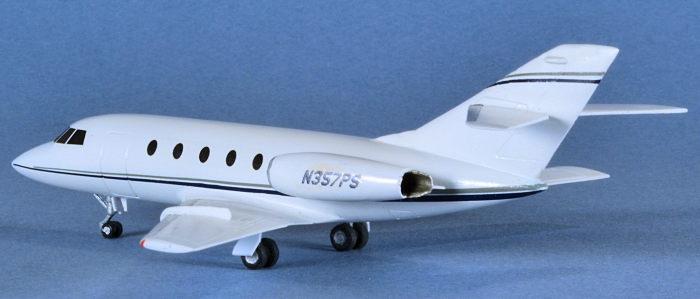 very well. The parts breakdown of the kit is like what youíd see
from any mainstream manufacturer. This turns out to be a bit too ambitious for
the short-run, low-pressure injected manufacturing process F-RSIN uses, so you
get thick sprues, lots of flash, short-shot parts, and thin spots. My kit had
cracks in the belly area of the fuselage where the plastic was tissue thin. The
tip of the tail also needed rebuilding.
very well. The parts breakdown of the kit is like what youíd see
from any mainstream manufacturer. This turns out to be a bit too ambitious for
the short-run, low-pressure injected manufacturing process F-RSIN uses, so you
get thick sprues, lots of flash, short-shot parts, and thin spots. My kit had
cracks in the belly area of the fuselage where the plastic was tissue thin. The
tip of the tail also needed rebuilding.
Detail is sparse but adequate for this scale, and the smaller parts like the wheels and engines would have been far better had they been cast in resin. The wings consist of upper and lower halves, and two sets of engines are included: CF700s for an original Falcon 20 and ATF3 turbofans for a Falcon 200 or HU-25 Guardian. Other parts for the 200/HU-25 include a new fin leading edge part with a small air scoop and a pair of shorter wing fences. Each kit has laser-printed decals for one jet, in my case, a Pan American Business Jets Division jet. Other versions of the kit include markings for Rťpublique FranÁaise and Air France jets. If you can get a response from him, Jbot has decals for several Falcon 20s, including a Federal Express jet.
| CONSTRUCTION |
Construction started with cutting out the fuselage parts and replacing the too-thin part of the belly of the model with styrene sheet. I then went through the rest of the large parts and cleaned them up by cutting away the flash and sanding away the molten plastic that had dripped on some parts. I glued the nose gear well in place, and added some weight on top of it before closing up the fuselage.
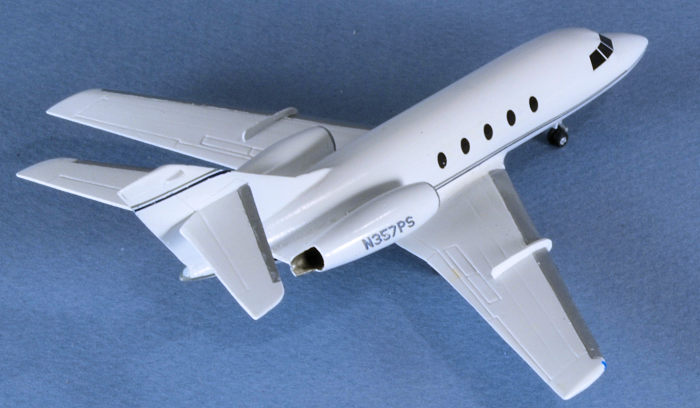 Every part needed some kind
of cleanup before it could be attached to the model. I had to trim and sand the
lower wing halves so they would fit the upper halves, then I thinned the
mounting tabs so they would fit into the slots in the fuselage. Having each wing
in two parts is unnecessary for a model this size, and just adds more work to
the cleanup process. The plastic is so soft that a medium grit sanding stick
will remove a lot of plastic in a hurry, so the cleanup went relatively quickly.
I used super glue to fill the modelís considerable gaps in the wings and
fuselage, and then sanded the trailing edges of the wings and tail to give them
a more scale thickness. The long wing fences are very fragile, and both broke
while I was removing them from the thick sprues.
Every part needed some kind
of cleanup before it could be attached to the model. I had to trim and sand the
lower wing halves so they would fit the upper halves, then I thinned the
mounting tabs so they would fit into the slots in the fuselage. Having each wing
in two parts is unnecessary for a model this size, and just adds more work to
the cleanup process. The plastic is so soft that a medium grit sanding stick
will remove a lot of plastic in a hurry, so the cleanup went relatively quickly.
I used super glue to fill the modelís considerable gaps in the wings and
fuselage, and then sanded the trailing edges of the wings and tail to give them
a more scale thickness. The long wing fences are very fragile, and both broke
while I was removing them from the thick sprues.
Both sets of engines require reconstructive surgery, since the respective nacelle halves donít match up very well. I briefly toyed with the idea of reworking the ATF3 engines to look like 731s, but I decided I had already spent enough time on the model and just went with with the early CF700s. I added styrene tube to the inside of the intakes to represent the prominent intakes for the high pressure sections of the engines, visible just inside the openings of the nacelle intake ducts, but I didnít feel courageous enough to attempt the four vanes that support them.
| COLORS & MARKINGS |
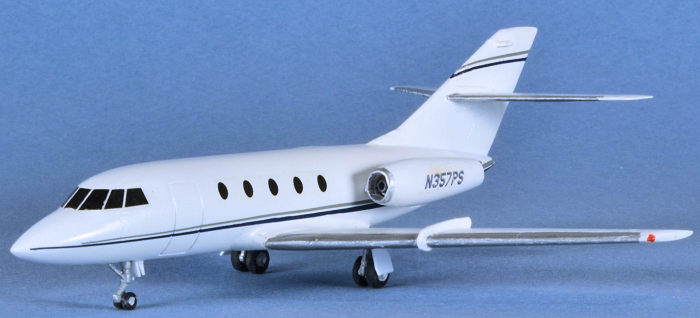 I primed the model with
Tamiya white primer, followed by a couple of coats of Future. I browsed
Airliners.net until I found a paint scheme that I liked that would be easy to
duplicate. I cut the fuselage and tail stripes from Microscale decal film and
printed some registration numbers of a real Falcon 20 to match the stripes. I
used the window decals from the kit and silver decal film for the wing and
horizontal stabilizer leading edges. My plan to use decal film led to a lot pain
and agony. After dipping in water, all three colors of the decal film crumbled
the instant I touched it, leading to many experiments with Future and liquid
decal film, none of which produced satisfying results.
I primed the model with
Tamiya white primer, followed by a couple of coats of Future. I browsed
Airliners.net until I found a paint scheme that I liked that would be easy to
duplicate. I cut the fuselage and tail stripes from Microscale decal film and
printed some registration numbers of a real Falcon 20 to match the stripes. I
used the window decals from the kit and silver decal film for the wing and
horizontal stabilizer leading edges. My plan to use decal film led to a lot pain
and agony. After dipping in water, all three colors of the decal film crumbled
the instant I touched it, leading to many experiments with Future and liquid
decal film, none of which produced satisfying results.
| FINAL CONSTRUCTION |
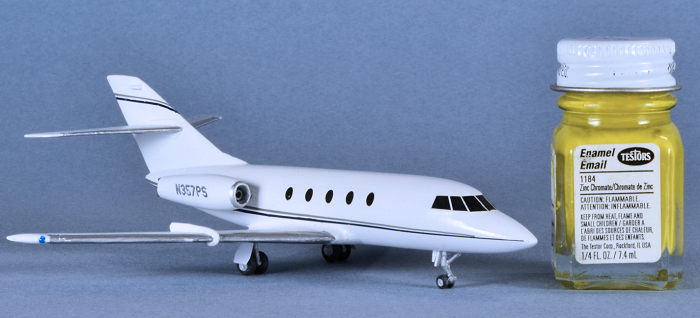 This model is perfect for mounting on an
acrylic rod and a small base, but Iíve always liked how the Falcon 20 crouches
on the ramp with its trailing link landing gear, so I had a lot more work to do
to clean up the landing gear parts. There are no axles for the wheels, so I
drilled holes in the gear struts and added axles made from wire. I replaced all
of the overly-thick gear doors with styrene sheet, but had trouble getting the
right size for the main gear doors. Iím not sure if the struts are too short or
if the gear bay openings are too large. I ended up reducing the size of the
doors and adding a pad in the gear well to lengthen the strut in an effort to
get the doors to fall across the main gear wheels in the correct position. The
main gear wheels look a little large to my eye, which probably contributed to
the problem. The shape of the nose gear strut is not quite right, but I left it
alone, so as not to weaken it. Once the battle with the landing gear was fought
to a draw, I added some antennae and finally called this one finished.
This model is perfect for mounting on an
acrylic rod and a small base, but Iíve always liked how the Falcon 20 crouches
on the ramp with its trailing link landing gear, so I had a lot more work to do
to clean up the landing gear parts. There are no axles for the wheels, so I
drilled holes in the gear struts and added axles made from wire. I replaced all
of the overly-thick gear doors with styrene sheet, but had trouble getting the
right size for the main gear doors. Iím not sure if the struts are too short or
if the gear bay openings are too large. I ended up reducing the size of the
doors and adding a pad in the gear well to lengthen the strut in an effort to
get the doors to fall across the main gear wheels in the correct position. The
main gear wheels look a little large to my eye, which probably contributed to
the problem. The shape of the nose gear strut is not quite right, but I left it
alone, so as not to weaken it. Once the battle with the landing gear was fought
to a draw, I added some antennae and finally called this one finished.
| CONCLUSIONS |
The note on the box
says this kit is ďfor the enthusiastic modeler,Ē which is definitely true.
Youíve got to really want a Falcon 20 in your collection to plow through
this one, although almost all of the kitís problems are due to the limitations
of the injection molding system used to produce it. F-RSINís kit eventually
builds into a very nice little Falcon 20, but the world is still waiting for a
good kit of this beautiful airplane (preferably in 1/48 scale!). I understand
this kit was released in injected form to keep the price down, but perhaps
F-RSIN would consider someday releasing this subject as part of their line of
excellent resin kits, to give the model a much higher level of detail and
finish. More detailed engines (plus a set of 731s), better landing gear, and a
cast-in nose weight, like they have on their Brasilia kits, would make for a
very nice model.
| REFERENCES |
Wikipedia
Airliners.net
2 July 2018
Copyright ModelingMadness.com
If you would like your product reviewed fairly and fairly quickly, please contact the editor or see other details in the Note to Contributors.
Back to the Main Page Back to the Review Index Page Back to the Previews Index Page